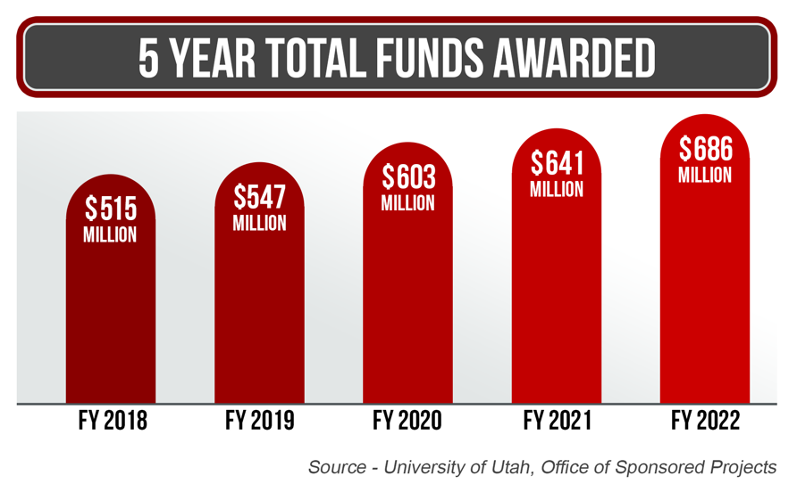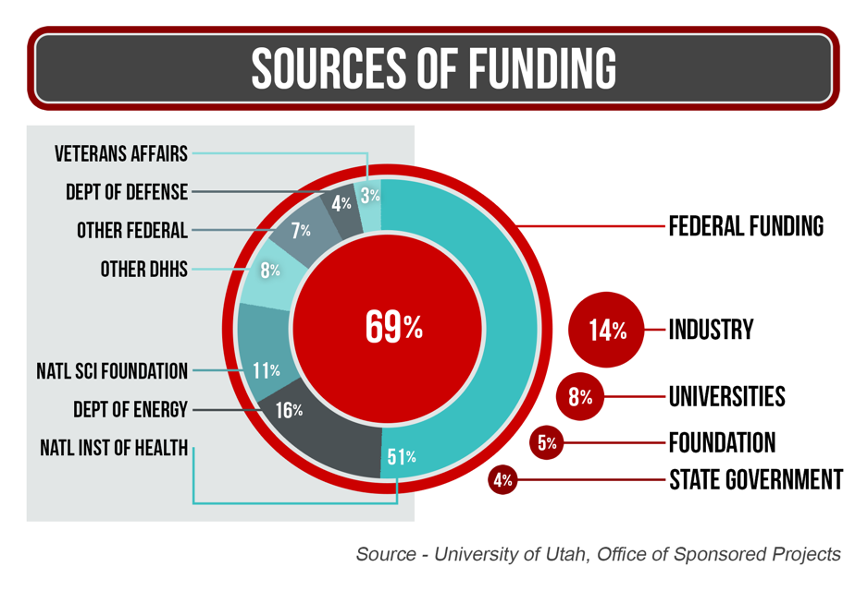For the ninth year in a row, research funding at the University of Utah grew, totaling $686 million in fiscal year 2022, which ended on June 30. The total is a new record high for the university. The U achieved milestones of $600 million in funding the last two years and $500 million four years ago.
"Research is one of our key foundations of our university," said Dr. Erin Rothwell, interim vice president for research. "Our students, faculty, staff and donors are continuously working together to bring solutions to some of the biggest challenges we face today as a society."

As a member of the prestigious American Association University, the U is known for its diverse disciplines in medicines, science, social work, arts and more. This fiscal year, research grants were awarded to more than 18 colleges in diverse disciplines across campus.
Highlights from our research funding
From medicine to fine arts, research at the U spans across many studies, as growth in funding continues moving upward. The School of Medicine grew the most in funding dollars with $331 million, a 15% growth from the previous fiscal year. The College of Education has a 43% funding growth from FY2021, with $5.6 million in funding. The Scientific Computing and Imaging Institute saw an 88% growth, with $16 million in FY2021. In addition, the College of Fine Arts saw its total funding dollar grow to $1.8 million, a 23% funding growth from the previous year.

Although these are some of the highlights, studies by our researchers from multiple disciplines were awarded research funding in data generation, parent-child relationships, cyberinfrastructure, and integrative health. Some of the many funding sponsors include the National Institutes of Health, the United States Department of Defense, and the National Science Foundation.
U research's impact on Utah's economy
U research is a major contributor to our local economy. The institution has almost 8,000 employees who are compensated by research dollars.
"Research funding is not only helping make progress in the research itself, but also helping many Utahns personally and economically," said Rothwell. "Over the last three years, research has supported $598 million in wages that contributes to the economic engine across the state of Utah."
Discovering solutions for a better future

Thanks to its dedicated researchers and generous donors, the U continues to move forward in breaking new ground, innovating, and discovering solutions to issues that impact the global community.
"Research is all about helping people," said Rothwell. "The continued growth of our university's research funding shows that many are excited and want to be a part of the solutions to the issues we face locally, nationally and globally."
University President Taylor Randall said the U's goal of reaching $1 billion in research funding annually will help the institution strive toward an objective of becoming a top-10 public university.
"Research funding at the university has increased annually for the past nine years. This is the trajectory we need to be on to have unsurpassed societal impact," said Randall. "Through the hard work and dedication of our research community, the U is positioning itself to be a major player in developing solutions to the world's grand challenges like climate change, mental health, cancer and more."






